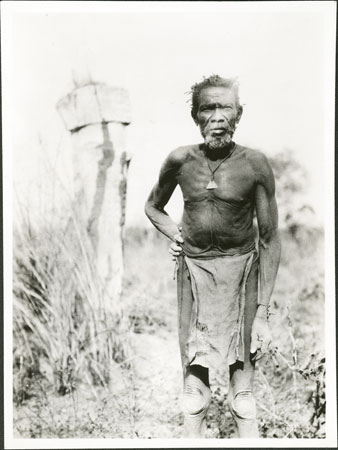Avokaya termite-mound grave

100 x 73 mm | Print gelatin silver
Condition:
Silver sulphide staining [EE 1989]
Date of Print:
Unknown
Previous PRM Number:
EP.M.14
Previous Other Number:
97; handlist no. 340
Accession Number:
1998.345.14
Description:
An old man stands on a path with a carved grave-post behind him, set on top of a termite mound within which the grave shaft has been dug.
Large mounds of this sort were selected near to a deceased man's home for his burial, and the post (known as lusi) were seen as representations of the dead man or woman, with prominance given to the umbilicus.
Photographer:
Edward Evan Evans-Pritchard
Date of Photo:
1927
Region:
[Southern Sudan] Western Equatoria Amadi District ?Woonibah area
Group:
Avokaya
PRM Source:
Edward Evan Evans-Pritchard
Acquired:
Donated 1966
Other Owners:
E. E. Evans-Pritchard Collection
Class:
Death , Carving , Physical Anthropology
Keyword:
Grave , Grave Marker
Documentation:
Original catalogue lists in Manuscript Collections. Additional material in related documents files. [CM 27/9/2005]
Primary Documentation:
PRM Accession Records - Accession Book Entry [p.
98] 1966.27 [1 - 24] G[ift] PROFESSOR E.
E.
EVANS-PRITCHARD; INST.
OF SOCIAL ANTHROPOLOGY, 51 BANBURY RD.
OXFORD - 1966.27.19 - S.
SUDAN, DARFUNG.
VARIOUS TRIBES.
Box of negatives in envelopes, [1 - 242] & 1966.27.20 - Box of prints of these negatives [refers to object 1966.27.19] [1 - 242], in envelopes.
Manual Catalogues [typewritten, entitled "Moro"] - 340. Ant-hill grave
Note on print reverse ms blue pencil - "340 Moro"
Notes on card mount ms pencil - "SSS overall 8.89"
Manual Catalogues [typewritten, entitled "Moro"] - 340. Ant-hill grave
Note on print reverse ms blue pencil - "340 Moro"
Notes on card mount ms pencil - "SSS overall 8.89"
Other Information:
In C.G.
& B.
Seligman's Pagan Tribes of the Nilotic Sudan (London, Routledge 1932, page 487) they note that 'south of the Moro live the Abukaya ..
[t]hey select a large ant-hill in the neighbourhood of the dead man's home and dig down from the summit.
A trench is dug in this, and perhaps a smaller trench in the bottom of the first, the body being covered by a layer of horizontal stakes plastered over with clay; the grave is filled in, and a neatly plastered conical mound is built over it.
This is surmounted by a tall carved wooden post, called lusi, made from the trunk of a tree rounded and carved at the top ...
The lusi, while not carved in the likeness of a human figure, was nevertheless held to represent the dead man or woman, and the prominence given to the umbilicus will be noted.' In his article Avokaiya Fishing in Man, 1928 (March) no.27, 37-38, E.
E.
Evans-Pritchard notes that 'during a stay of six or seven weeks amongst the so-called Moro tribes on the west bank of the Nile, in Mongalla Province of the Anglo-Egyptian Sudan I spent four days to the west of the Yei river, where the southern Moro are mingled with the Fajellu people and the Avokaiya, as this people is usually called.' Since his 1937 article states that he trecked from Amadi to Woonibah and then back via Lanyabah, I have presumed that his encounters with Avokaiya were in the vicinity of Woonibah, which is to the west of the Yei river.
[Chris Morton 2/3/2004]
Recorder:
Christopher Morton 2/3/2004 [Southern Sudan Project]

